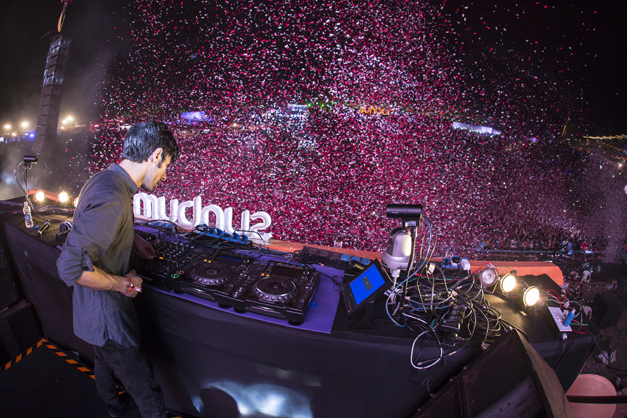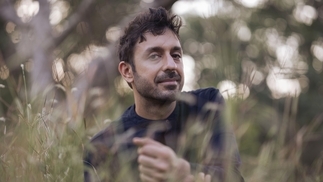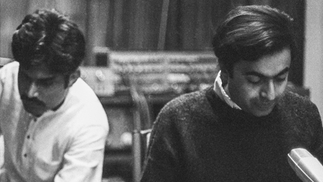KSHMR is the Prince of cinematica: DJ Mag USA Cover Feature
We meet the Indian DJ causing a riot...

The fortunes of Niles Hollowell-Dhar, aka KSHMR (pronounced ‘Kashmir’), have skyrocketed since he adopted his chosen moniker, with a nod to his Indian heritage. The former rap/pop producer has taken the EDM world by storm with his emotive, cinematic productions, and is set to make even more of an impact during Miami Music Week this month with shows at Ultra Music Festival and beyond...
Words: LILY MOAYERI
Cover Pic: CHRISTOPHER PARSONS Live Pics: AJR PHOTOS
---------------------------
Niles Hollowell-Dhar pads softly in his socks and a cozy hoodie around a multi-storey house in the affluent neighbourhood of Bel Air in Los Angeles. Hollowell-Dhar, who in dance music circles is known as KSHMR, doesn’t live here. His home is 20 minutes away. He has taken this house for a week as a place to work, amassing germs of song ideas, and in some cases, finished songs.
Holed up at the very top of the house, he has assembled a studio in the same room in which he is sleeping. Hollowell-Dhar is here with his best friend, but the house feels empty. Away from his million-plus Facebook followers, his tens of thousands of likes on Instagram, his hundreds of reactions to every tweet, his formidable, international tribe of devoted fans, and his impressive list of studio collaborators, Hollowell-Dhar is alone here in the real world.

He settles on the couch, cross-legged, his knees impressively low, frequently cracking his knuckles, but more often, his toes. From the top of his T-shirt, which covers his almost concave chest, an intricate tattoo peeks out. His luxurious jet-black hair, courtesy of his part-Indian heritage, is the perfect degree of wavy to make it interesting but not unmanageable. His face is half-covered by his glasses and his tone is earnest, going almost into a Christopher Walken sing-song when he gets caught up in responding to a question by telling a long-winded but entirely connected story. He would be nerdy, if he weren’t so good looking.
At 28 years of age, Hollowell-Dhar has already had two highly successful — and for the most part, unrelated — careers as a musician. First as one-half of The Cataracts, the hip-hop-turned-pop project he started with David Singer-Vine some 13 years ago when they were attending high school in the Bay Area. The duo was responsible for the monster hit with the Far East Movement, ‘Like A G6’, as well as penning songs for Selena Gomez, Jason Derulo, Snoog Dogg and Enrique Iglesias, among many others.
For the last three years, Hollowell-Dhar has experienced similar accolades as KSHMR — his solo dance project. The KSHMR name has appeared on tracks alongside heavyweights such as Tiësto, R3hab, Bassjackers, Carnage, Firebeatz, Headhunterz, to name just a few. Although have a cursory listen to his non-collaborative KSHMR material — ‘Megalodon’, ‘Dead Mans Hand’, ‘Jammu’ or his 12-track EP and accompanying book, ‘The Lion Across The Field’ — and it is apparent Hollowell-Dhar is just as strong, and even more inventive, on his own. Although he is more than a contender in the dance music world, he speaks of it with a removed perspective and refers to its skilled producers like he is not one of them.
“Pop music was becoming a job where you go into a studio and try to figure out what a hit sounds like, what a mass audience is going to buy into,” states Hollowell-Dhar. “I slowly forgot what it was that I loved about making music. [Singer-Vine] got the emotional memo first. He knew the heart and soul of what we were doing was getting lost — and he left. That forced me to realize I needed to find something new, and I came up with KSHMR.
INDIAN
“When I was young, it never struck me as particularly interesting that I was Indian— I just wanted to fit in, being normal is really paramount in the playground,” he continues. “It wasn’t until I started more of an inward journey into who I really was, which happened at my departure from pop music, that I thought, ‘If I’m going to have one legacy in music, what is it going to be?’ The simplest thing was to think about my heritage. I began to appreciate — as most people do when they become adults — what makes me different. The stable pop train I was on needed to break down to start that conversation with myself.”
Hollowell-Dhar has always had a strong connection to his Indian roots. His father came to the United States from Kashmir, India — where the moniker KSHMR is derived from — at the age of 25. He married Hollowell-Dhar’s American mother, but kept his obligations to his family in India by making regular visits home every couple of years with his son in tow. These powerful bonds are also the ones that initially restricted Hollowell-Dhar from pursuing music, the expectation being that he would go to college and follow a conventional career path. He did what was required of him for a year, but had to stop to give music a serious shot. His family only came to terms with his music career because they could hear his songs on the radio.

“Hearing a song on the radio fits the universal criteria of somebody is doing something right in the music industry,” Hollowell-Dhar says matter-of-factly. “Really, they just want something they can fit into an impressive blurb they can mention when they’re talking to their friends. I noticed that a lot in India, worrying about what other people think and keeping a certain profile — even in the little community my grandpa lives in. With all of the pressure to succeed, it becomes blurry as to who it is really for.”
Hollowell-Dhar segued into dance music superstar through the unlikely portal of ghost producing. This was not a calculated move, just him helping a friend in the studio — something that comes naturally to Hollowell-Dhar. Even now, he spends a great deal of time conducting tutorials and sharing sample packs through the collaborative music creation platform Splice, as well as running masterclasses and giving away the stems for his songs.
The producer community is important to him and Hollowell-Dhar wants to be important in kind, exhibiting what he has created and being unapologetic about it. In retrospect, there could not have been a better way for him to make the shift while maintaining no connection between The Cataracts and KSHMR — a factor essential to Hollowell-Dhar more than ghost productions. The positive reaction to his ghost productions gave him the confidence to put himself forward in dance music on his own, although for the first year he was insistent on remaining faceless, and in the process, creating mystery around KSHMR.

“At the time, dance music was uplifting and euphoric,” says Hollowell-Dhar. “Everybody was on the same page about it. It was almost like there was a DJ outfit to wear and a DJ hand gesture when you’re playing your song. It was like a gold rush that’s so new, if you just follow these steps, you could be a big DJ. Anybody who has seen anything cyclical in music knows that only lasts so long, and most people get left in the eyes of history looking like imitators. The people that stand out do so because they approached it from a very genuine way and in most cases, popularised it and set the template for others. I saw an opportunity to create this world around KSHMR that was darker and had more drama, more edge, with aspects of cinematic scoring, to present people with something contrary to how everything was.”
“It was like starting from scratch for me,” he continues. “I had a fresh slate. It was so revitalising. Every day I was thinking of anything and everything I could do with this project using all I learned having gone through the music industry. The dance music world affords you complete freedom from rules. It’s difficult to categorise exactly what pleases the dance community. It seems to be a whole range of things. But if you’re offering something new, it quite often does the trick.”
STORYTELLING
His absence from the public eye for the first year of KSHMR afforded Hollowell-Dhar the time to be prolific, producing enough music to have a whole set of just his own tunes when he finally did emerge from hiding. This helped solidify the world of KSHMR through his underlying goal of getting his musical message across through storytelling. The KSHMR show has a narrative that is relayed through not just multi-dimensional music, but also words and a visual component of illustrations, animation and lights. It is told in chapters that you should be present for to follow the script, with the hero of the story being each member of the audience. This idea, in large part, is to keep the audience in place from start to finish, not running from stage to stage at a festival, catching snippets here and there.
“One of the earliest thoughts I had when I saw the crowd all looking at the DJ was imagining them like an army following a commander, which was an unusual take on it since the vibe of the rave is about peace, love, unity, respect,” says Hollowell-Dhar. “I thought it would be interesting to try something that sounded like that, so my earlier work is menacing and military-esque. At the time, it was a new area in the spectrum of emotion for the sphere of dance music.
“Dance music is a challenge,” he continues. “With pop music, it’s about the vocal. With dance music, you have to be impressive with the production as it moves the whole responsibility of the song to satisfy the listener. When you’re working on music in the pop world, it is a very human experience. You have these checks and balances, people to stop you if you’re getting too crazy. Dance music is such a solitary art, you kind of have to bring people in to keep you from running your own songs to the ground, not knowing when to stop when you have something special, not realising in mistakes there is a lot of genius. You have this idea of what it should be. Somebody else can tell you when it’s great.”
His show has graduated to what Hollowell-Dhar presented at the DJ Mag Top 100 DJs Awards in 2016 when he walked away with the Highest Live Act award. This followed his first entry ever into the Top 100 DJs poll in 2015 at No.23, when he moved up to No.12 in 2016. The latest iteration of the show sees additional elements of scoring as well as a more tangible presentation with fire, wind, water, and snow, which Hollowell-Dhar will be unveiling at a special DJ Mag show during Miami Music Week.

“I’d like to tell a story to make people really feel, and have it give context to the music,” Hollowell-Dhar explains. “Dance music has been so synthetic. We’re entering an era where the human element is emerging. The electronic instruments of dance music have a specific quality of being very clean, quantized and in your face. Then you find something like a little flute with some cultural relevance or value. These old, traditional instruments almost have a human strain. They almost sound like they hurt when they go through a particular note. It seems like a great idea, but you quickly find these two types of instruments don’t play well together. So, you figure out how to incorporate them into a hit song — which was difficult to do in the first place. But that’s important to me, trying to give people a human behind synthetic instruments and MP3s.”
KSHMR references author Leonard Mlodinow, who puts forth ideas about the role of the subconscious in his book, Subliminal: How Your Unconscious Mind Rules Your Behaviour. His subconscious is something with which Hollowell-Dhar feels he is at war with when it comes to himself. “I feel the concern is with the equation of what people will like as the key to music,” he reflects. “I don’t think there is an equation. For me, all the progress I’ve made has been the equation of my own mind. How do I get myself into the state where I’m capable of creating?

“The way you succeed is by finding unity between your soul and what it wants, what you’re really good at, and how to present it,” he continues. “You put out 10 songs and one of them gets a response, and quite often, you’re not surprised. You knew there was some quality about that song when you made it. We just don’t know ourselves well enough. It’s all about learning ourselves, to gain the confidence that when you really listen to yourself, you’ll be rewarded. The temptation is, ‘I’ve got to hide myself as much as possible and not let anybody know that I’m this weirdo or I have these musical inclinations.”
At this statement, it seems the big empty house in Bel Air suits KSHMR’s creative thought process perfectly. However, the solicitous producer with good looks to boot isn’t a total recluse. “There are so many things that you spend so much time hiding because you feel you’re never going to get anywhere with them,” he adds. “Then a couple of them slip through the cracks and you realize that’s the whole key.”





